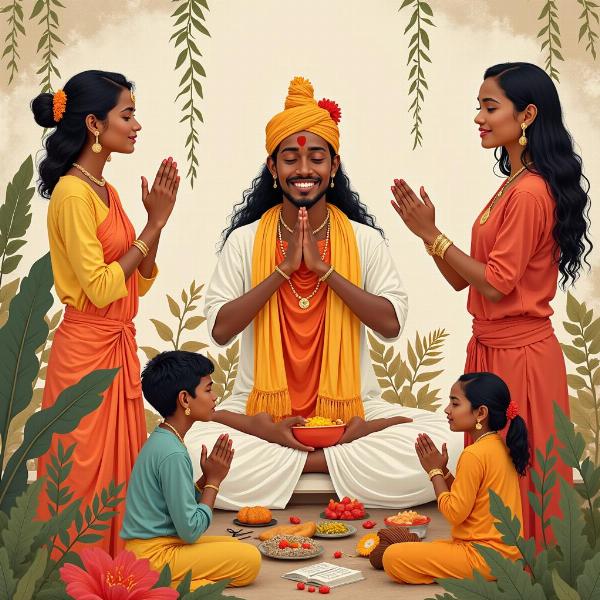Devotional paths to the divine, or “bhakti marg” as it is known in Hindi, represents a core concept in Indian spirituality. Understanding its meaning and the various forms it takes is crucial for anyone exploring Hinduism and its rich tapestry of beliefs. This article delves into the essence of devotional paths, exploring their significance in Hindi and offering insights into the different ways individuals connect with the divine.
Exploring Bhakti Marg: The Path of Devotion
The term “bhakti” itself translates to devotion, love, or attachment to the divine. “Marg” means path or road. Therefore, “bhakti marg” signifies the path of devotion as a means to achieve spiritual liberation or moksha. It emphasizes a personal and intimate relationship with God, often visualized in a specific form or deity. This personalized connection forms the cornerstone of bhakti marg.
 Visual Representation of Bhakti Marg
Visual Representation of Bhakti Marg
Diverse Forms of Bhakti: A Rich Tapestry of Devotion
Bhakti in Hinduism isn’t monolithic. It embraces a wide spectrum of practices and approaches, catering to individual temperaments and preferences. Some common forms include:
- Sargun Bhakti: Devotion directed towards a deity with attributes and form. This could be Krishna, Rama, Shiva, Durga, or any other deity from the Hindu pantheon.
- Nirgun Bhakti: Devotion directed towards the formless, absolute aspect of the divine. This path emphasizes meditation and contemplation on the abstract nature of God.
This diversity allows individuals to connect with the divine in a way that resonates with their personal beliefs and understanding.
The Role of a Bhakt: Embracing Devotion
A “bhakt,” a devotee, plays a crucial role in the bhakti tradition. Bhakti emphasizes the importance of surrender, faith, and love as the primary means of connecting with God. A bhakt engages in various devotional practices, such as singing devotional songs (bhajans and kirtans), reciting prayers, performing rituals, and engaging in selfless service.
Devotional Paths and the Concept of Moksha
The ultimate goal of following a bhakti marg is often seen as achieving moksha, liberation from the cycle of birth and death. Through unwavering devotion and love for God, the bhakt seeks to transcend the limitations of the material world and merge with the divine. This pursuit of liberation forms a central theme within many devotional traditions.
Key Elements of Devotional Paths in Hindi
Several key elements characterize devotional paths in the Hindi context:
- Shraddha (Faith): Unwavering belief in the chosen deity and the path of devotion.
- Prema (Love): Intense love and affection towards the divine.
- Samarpan (Surrender): Complete surrender of the ego and desires to the will of God.
- Seva (Service): Selfless service to God and humanity as an expression of devotion.
These elements weave together to create a profound spiritual experience for the devotee.
Conclusion
“Devotional paths to the divine meaning in Hindi” encompasses a rich and multifaceted understanding of bhakti marg. From the different forms of bhakti to the role of a bhakt and the ultimate pursuit of moksha, the concept highlights the profound impact of devotion in Hindu spirituality. Understanding these various facets offers valuable insights into the heart of Indian religious and cultural traditions.
FAQ
- What is the difference between Sargun and Nirgun Bhakti? Sargun Bhakti involves devotion to a deity with form, while Nirgun Bhakti focuses on the formless aspect of God.
- What is the role of a Sant in Bhakti Marg? A Sant is a spiritual teacher who guides devotees on their path of devotion. You can learn more about this on our page about sant meaning in hindi.
- How does Bhakti lead to Moksha? Through unwavering devotion, a bhakt seeks to transcend the material world and merge with the divine, achieving liberation. For a deeper understanding of this concept, you can refer to our page on the hindi meaning of salvation.
- What is the significance of Bhajans and Kirtans? Bhajans and Kirtans are devotional songs that evoke feelings of love and devotion towards God. They are an integral part of many bhakti traditions. The word “bhakt” itself has significant meaning in Hindi, explore it further on our bhakt meaning in hindi page.
- What are some examples of devotional practices? Devotional practices can include prayer, chanting, meditation, fasting, pilgrimage, and selfless service. For further insight into a particular form of devotion, you can visit our sargun meaning in hindi page.
- Is there a connection between Bhakti and Karma? While distinct paths, both Bhakti and Karma contribute to spiritual growth. Bhakti emphasizes devotion, while Karma emphasizes actions and their consequences. To understand “Moksha” in Hindi, explore our mosha meaning in hindi page.
- How can I start my journey on a Bhakti Marg? Begin by exploring different devotional traditions and finding a path that resonates with you. Connect with experienced practitioners and learn from their guidance.
Meaning-Hindi.in is your trusted partner for all your Hindi translation needs. We specialize in various translation services, including business and commercial documents, legal and certified translations, technical manuals, website localization, and academic materials. We also provide expedited translation for urgent requests. Need help understanding the nuanced meanings of spiritual texts? Our expertise in specialized translations ensures accuracy and cultural sensitivity. Contact us today at [email protected] or call us at +91 11-4502-7584. Meaning-Hindi.in is committed to delivering high-quality translations that bridge language barriers and foster effective communication.